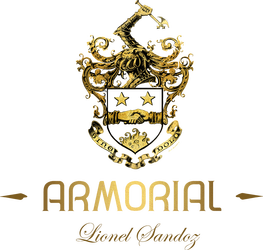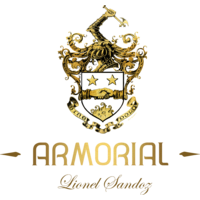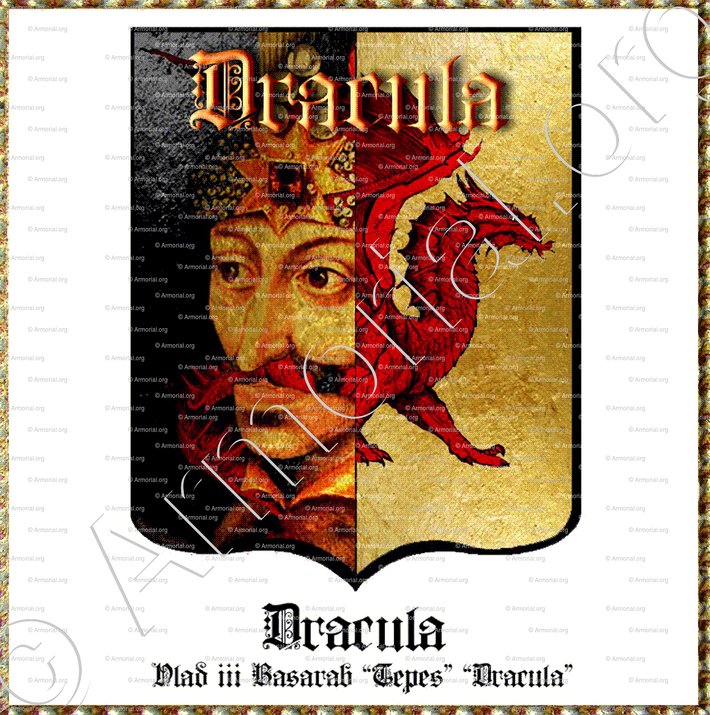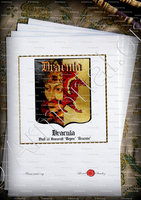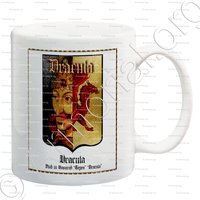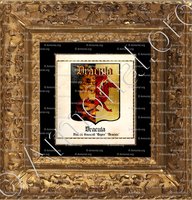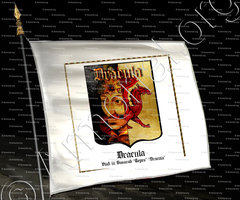DESCRIPTION
DRACULA
Zara romanesca (Terre romaine).
România
- Dracul ou Drăculea, Dracula, Dracules, Dragulios.
Armoiries parlantes:
" Parti de sable et d'or, à un dragon de gueules sur le parti. "
Le voïvode Vlad II Dracul, ou Drăculea, Dracula, Dracules, Dragulios, (vers 1395 - décembre 1447) fut le prince de Valachie de 1436 à 1442 et de 1443 à 1447.
Vlad II rejoint l'Ordre du Dragon en 1431, d'où son surnom le Dragon, Dracul.
Les objectifs principaux de cet ordre étaient la protection des intérêts de la Chrétienté et la croisade contre les Ottomans.
L'Ordre avait comme symbole un dragon.
Vlad accole d'ailleurs lui-même à sa signature son surnom dans les textes officiels, et son blason porte la figure d'un dragon. (Wikipédia)
Note:
Les Roumains sont les descendants de ces citoyens et de ces légionnaires que le vainqueur de Décébale, Trajan, envoya coloniser la Dacie.
Cette nation constitue ainsi un rameau détaché de la grande famille des peuples romans ou néo-latins; elle est entourée de populations slaves ou magyares, qui l'ont soumise sans pouvoir l'absorber.
Le nom de Valaque est étranger (en serbe "Wla" , en hongrois "Olah" ; c'est- à dire Welsch ; en polonais "Vloch" signifie Italien) le peuple ne se donne d'autre nom que celui de "Romouni", et il appelle sa patrie Zara romanesca (Terre romaine)
Les Valaques disent d'eux-mêmes : "Noi suntem di sangue Rumena." (Nous sommes de sang romain).
Ils tutoient tout le monde, comme les anciens Romains.
La haine et le mépris pour le nom de roi s'est perpétué, quoiqu'à leur insu dans leur coeur, et cette expression : "Esci un craiu" (Tu es un roi), ne signifie pas autre chose que : "Tu es un homme sans foi ni loi, un drôle." (Revue Suisse, vingt-quatrième année, janvier 1861, Neuchâtel.)
******
DRACULA
Zara romanesca (Roman Land).
Romania
- Dracul or Drăculea, Dracula, Dracules, Dragulios.
Coats of arms:
"Party Sable and Or, to a dragon Gules on the parti."
Voivode Vlad II Dracul, or Drăculea, Dracula, Dracules, Dragulios, (c. 1395 - December 1447) was Prince of Wallachia from 1436 to 1442 and from 1443 to 1447.
Vlad II joined the Order of the Dragon in 1431, hence his nickname the Dragon, Dracul.
The main objectives of this order were the protection of the interests of Christianity and the crusade against the Ottomans.
The Order had a dragon as its symbol.
Vlad also adds his nickname to his signature in official texts, and his coat of arms bears the figure of a dragon. (Wikipedia)
Note:
The Romanians are the descendants of those citizens and those legionaries whom the conqueror of Decebalus, Trajan, sent to colonize Dacia.
This nation thus constitutes a branch detached from the great family of the Romanesque or neo-Latin peoples; it is surrounded by Slavic or Magyar populations, who have subjugated it without being able to absorb it.
The name Wallachian is foreign (in Serbian "Wla", in Hungarian "Olah"; that is to say Welsch; in Polish "Vloch" means Italian) the people give themselves no other name than that of "Romouni" , and he calls his homeland Zara romanesca (Roman Land)
The Vlachs say of themselves: "Noi suntem di sangue Rumena." (We are of Roman blood).
They call everyone familiar, like the ancient Romans.
The hatred and contempt for the name of king has been perpetuated, although without their knowledge in their hearts, and this expression: "Esci un craiu" (You are a king), does not mean anything other than: "You are a man without faith or law, a joker." (Swiss Review, twenty-fourth year, January 1861, Neuchâtel.)
SHARE ON SOCIAL NETWORKS
OPINIONS
There are no notes at this time. Be the first to rate!
GIVE A NOTE
